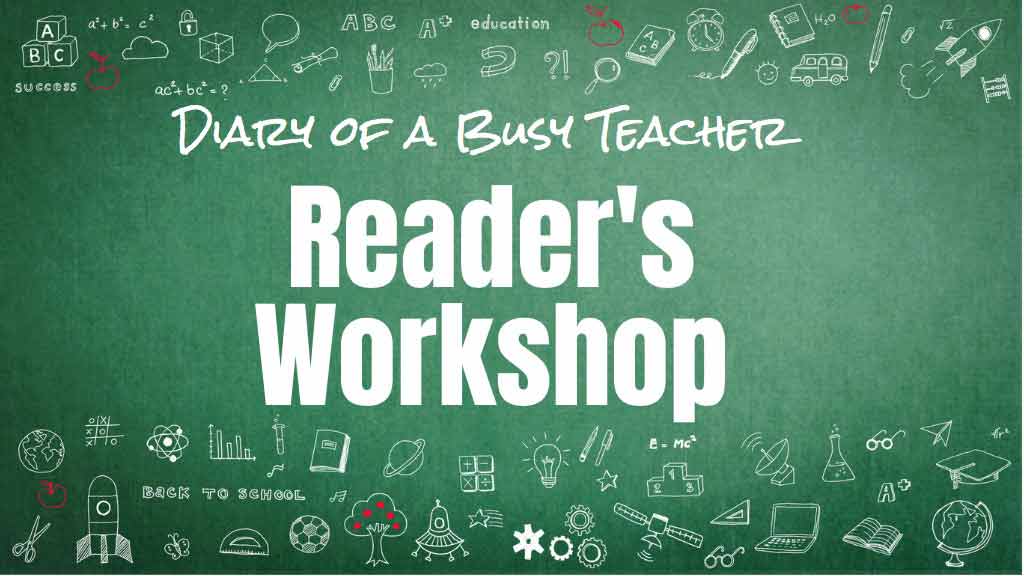TeacherVision Advisory Board member, Lisa, outlines the expectations for facilitating a Reader's Workshop, and the reality of what happens in the classroom. She provides helpful tips, so you can set yourself up for success.

Hello reader, and thanks for your continued interest in Diary of a Busy Teacher. If you are just tuning in now, buckle up while I pull open my classroom door, and share the reality of teaching. Today we tackle: Reader’s Workshop. For me, this is one of the most challenging parts of the day, and what I expect doesn't always match reality.
Expectation: Reader’s Workshop is Just Reading
It’s amusing to me that non-teachers often assume that reading time is just reading: no lesson, no reader’s notebook to record thinking, no strategy groups, just reading. The reality is that reader’s workshop is so much more than opening up a book.
Expectation: How Reader’s Workshop is Structured
In my district, we use Lucy Calkins’ reading and writing program. The workshop model begins with a teacher-led mini-lesson (no more than ten minutes) that introduces students to a reading strategy they can use when reading independently. One of the lesson goals is to support students to understand why they are learning this strategy, and how it can help them become better readers. Students then practice using the strategy. an active engagement time where they practice using the strategy.
Then, during independent work time, I will take a minimum of two small strategy groups of four to five kids to work on a reading skill they need support with. I take notes on how the groups and conferences went in order to plan to extend or re-teach next time. Sometimes, at the end, students will Turn and Talk to share out to the class at the end.
Reality: What Reader’s Workshop Really Looks
The ten-minutes long Lucy Calkins’ lesson plan is sixteen pages long, and has ten accompanying links and resources. In addition to the curriculum provided by the district, I have a huge Google folder organized right down to the very lesson I am on, filled with resources, Google docs of typed out material the kids need to see on the projector, papers to print out so they have a place to record their thinking, and more, all created by my school’s fourth grade team of myself and one other person. It has taken years to pare down the mini-lesson to ten minutes, but I am usually successful, or make it in under fifteen.
During the 30-minute independent work time, this happens:
“Ms. Koplik, can I go to the bathroom?”
“Ms. Koplik, I can’t find my pencil.”
“Ms. Koplik, I don’t know what book to read.
“Ms. Kop---” You get the picture.
Meanwhile, I am scrambling to find the haphazardly written Post-It of information about my kids from the previous day to remember which group I meet with on which day and about what and when I met with them last and whose turn it is today. Then, I take a breath. There it is, a neon pink Post-It underneath 47 papers I pushed aside that somehow ended up on my desk in a three hour span from when it was last clean.
By the time I am settled at the back table with my small group of kids, once again, half the group has forgotten their reader’s notebook, a pencil, even their book. Sometimes, I forget my coffee at my desk. Sometimes, I forget my own reader’s notebook or pencil. But, it always comes together.
Then, the group goes something like this:
“Okay, everyone, I’ve called you over here today because...Johnny, stop talking to Nick.”
“Because we all need to work on...”
“I mean it, I can still see you.”
And on and on we go... Ultimately, I do teach the small groups, and maybe I don’t confer with as many students as I hoped. Or, I take time to meet with individual students, and skip out on a small group.
"All we can really do is appreciate those small groups and conferences we do successfully get to, knowing that we are working constantly to better our practices, our management systems, and our teaching. Even when we miss a group or we don’t take perfect notes, our students are still improving drastically in their reading, and it’s all thanks to us."
Tips and Tricks
- Create strategic seating placement for students so that they are in a place in the room where they will be the least distracted or distracting.
- Label your book bins not only by author or genre, but by Fountas and Pinnell Guided Reading Level, or Lexile, so you can easily consider what book may be appropriate for a student (if you use a benchmarking system throughout the year).
- When you consider reading partnerships, take into account the students’ reading levels as well as who they will and will not work well with socially.
- If you offer them graphic organizers or other papers, have them write their names on the papers immediately. This will avoid my favorite irritation of “whose paper is this?” when I pick it up from the floor.
- If you want to avoid loose papers, a great way to keep their thoughts organized is to use a Reader’s Notebook (a simple composition notebook works best).
- Try out a variety of management systems to keep track of your groups and conferences. I have used Evernote, Google Docs, hand drawn papers with kids’ names and space for notes (this works best for me), Post-Its, and share your ideas with colleagues.
Here are some additional resources to support you with Reader's Workshop: How To Use Reading Strategy Groups In Your Classroom and Reading Workshop.
What are your tips for facilitating Reader's Workshop? Share with us on Instagram, Facebook, Twitter, and Pinterest.
Lisa Koplik is a fourth-grade teacher at the Greenwood School in Wakefield, Massachusetts. She loves teaching math, reading intense read-aloud books that promote complaints when she has to stop reading, and figuring out educational games to play with her students. Check out her video series on classroom management!

